Abstract
The Lintong–Chang’an Fault Zone (LCFZ) is an important active structure in the Weihe Graben (central China). The study on the activity of the LCFZ is not only of great significance to explore the regional tectonic mechanism, but also has practical value in urban seismic mitigation and disaster relief. In this study, based on high-resolution remotely sensed imagery, shallow seismic reflection survey, borehole data and excavation of a foundation pit, we determined the distribution and activity of the Wangjiabian–Houjiawan fault (a branch fault of the LCFZ) in the Shaoling Loess Tableland. Combined with previous studies, we further inferred that the vertical displacements were 0–6 m along the LCFZ, but most displacements were around 1 m. Furthermore, there are eight locations where no displacements have been found in the Late Pleistocene strata. The offsets on the fault zone since the Late Pleistocene display a wave-like pattern, which is unrelated to the regional topographic expression. Compared to other faults in the Weihe Graben, the activity of the LCFZ in vertical component is relatively weak, implying a possible strike–slip motion. In addition, a major active fault may exist on the northwest side of this fault zone, bearing part of the fault motion in this region.
1. Introduction
The Lintong–Chang’an Fault Zone (LCFZ) is one of the major active faults within the Weihe Graben, and plays a crucial role in controlling the regional sedimentation processes [1,2,3,4,5,6]. The LCFZ is a concealed fault zone extending southwestward from Laomudian in the Lishan Mountain to Fengyukou Village at the northern foot of the Qinling Mountain, a distance > 50 km (Figure 1). The width of the LCFZ ranges from 1 to 10 km broadening southwestward. It strikes 35° to 50°, and dips to northwest at an angle of ~70°. The obvious geomorphic disparities can be observed on the two sides of the fault zone: the Weihe River terraces on the northwestern side and the loess tableland on the southeastern side (Figure 1c).
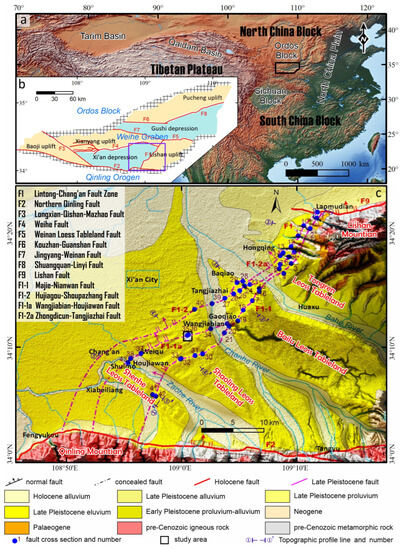
Figure 1.
(a) Topographic map on most of China. The black box shows the location of (b). (b) Sketch map of tectonic units and the main faults in the Weihe Graben. The purple box shows the location of (c). (c) Geological and geomorphic map illustrating the distribution of the Lintong–Chang’an Fault Zone. The resolution of the Digital Elevation Model data in (c) are 30 m.
In order to investigate the spatial distribution and the activity of the LCFZ, the Shaanxi Earthquake Agency conducted extensive surveys and explorations on this fault zone while undertaking the project “Active Fault Detection and Seismic Hazard Assessment in Xi’an City” [2,3,4,5,7]. The studies found that the fault zone is mainly composed by four approximately parallel splays: the Majie–Nianwan Fault (F1-1), the Hujiagou–Shoupazhang Fault (F1-2), the Wangjiabian–Houjiawan Fault (F1-1a) and the Zhongdicun–Tangjiazhai Fault (F1-2a) [2,3,5,7]. The Majie–Nianwan Fault merges with the Wangjiabian–Houjiawan Fault at Gaoqiao village on the right bank of the Chanhe River. Similarly, the Hujiagou–Shoupazhang Fault connects to the Zhongdicun–Tangjiazhai Fault at Tangjiazhai village (Figure 1c). Over 40 fault outcrops were discovered along the LCFZ in the project mentioned above. Hence, this fault zone is inferred to be active in the Late Quaternary, demonstrated by the observed displacements in the Late Pleistocene stratum of paleosol S1 [2,3,4].
Previous studies mainly focused on the northern part of the LCFZ, the Majie–Nianwan Fault (F1-1) and the Hujiagou–Shoupazhang Fault (F1-2) [2,3,4,5,7]. The investigation on the southern splays, especially the Wangjiabian–Houjiawan Fault (F1-1a), is quite limited because of its concealed nature and urbanization, further leading to ongoing debates and uncertainties as to its spatial distribution and Late Quaternary activity. Furthermore, the Wangjiabian–Houjiawan Fault (F1-1a) traverses the Qujiang New District in Xi’an City, which is a national cultural and industrial demonstration zone and a populated area in China. Therefore, the locations and deformation history of the Wangjiabian–Houjiawan Fault (F1-1a) need to be determined as accurately as possible in order to establish and implement building codes and zoning ordinances. Recognition of the fault activity is also critical for seismic hazard analysis and mitigation.
This study is based on the “Qujiang New District Phase II Project”, which aims to determine the locations and ages of active faults around the Yanxiang Road area in Xi’an City, thereby informing the future urban planning [8]. Therefore, we conducted a series of work on the Wangjiabian–Houjiawan Fault (F1-1a) around Yanxiang Road in the Shaoling Loess Tableland. To overcome challenges associated with evaluating the Late Quaternary movement across this concealed structure, high-resolution remotely sensed imagery data, high-resolution seismic reflection imaging, borehole data and excavation foundation pit profiles were utilized. The distribution and activity of the Wangjiabian–Houjiawan Fault (F1-1a) in the study area was thus determined. We further discuss the Late Pleistocene motion of the LCFZ, which is nonuniform and irrelevant with regard to the regional topography, and infer that there may have sinistral motions on the LCFZ and/or an additional active fault on the northwestern side.
2. Tectonic Settings
The Weihe Graben, where the LCFZ lies within, is dominated by normal faults and is situated between the Qinling Orogenic Belt and the tectonically stable Ordos Block. As one of the largest graben systems in China, the Weihe Graben involves an ENE–WSW-striking depression over an area of about 400 km × 100 km [9,10]. The graben formed during the Cenozoic, and is filled with a thick sequence of lacustrine and alluvial deposits covered by Quaternary loess [9]. The thickness of the Cenozoic deposits ranges from 2000 m to 7000 m, thinning northward [11]. During the Quaternary period, the Weihe Graben experienced intensive subsidence with the maximum deposits thickness exceeding 1200 m [12,13]. Over the past 3000 years, a total of 243 earthquakes have been recorded, indicating that neotectonic activity is significant within the graben. The largest earthquake was the M 8¼ Huaxian earthquake in 1556 CE, leading to 830,000 fatalities [14,15].
Due to the fault activities, multiple secondary faulted blocks were formed in the Weihe Graben, namely, Baoji Uplift, Xianyang Uplift, Pucheng Uplift, Lishan Uplift, as well as Xi’an Depression and Gushi Depression (Figure 1b). The LCFZ defines a boundary fault between the Xi’an Depression and the Lishan Uplift. The Xi’an Depression is one of the depocenters in the Weihe Graben, with the Quaternary deposits reaching more than 1000 m in thickness [12]. However, the Lishan Mountain underwent substantial uplift compared to the surrounding depressions since 8 Ma [16], resulting in Lishan Uplift became the highest region in the Weihe Graben. The apex of the Lishan Mountain reaches approximately 1300 m above sea level, ~900 m above the Xi’an Depression [12]. Within the Lishan Uplift, several loess tablelands were formed, namely, Tongren Loess Tableland, Bailu Loess Tableland, Shaoling Loess Tableland and Shenhe Loess Tableland, from northeast to southwest (Figure 1c), with the elevation descending southwestward. In general, since the Quaternary period, the hanging wall of the LCFZ has been characterized as an obvious subsidence area, while the footwall has experienced a relative uplift motion.
The Wangjiabian–Houjiawan Fault (F1-1a) of the LCFZ extends from Gaoqiao village at the southern edge of the Bailu Loess Tableland to the alluvial fan in the front of the Qinling Mountain (Figure 1c), about 35 km length. It passes through the Chanhe River, the Shaoling Loess Tableland, the Zaohe River and the Shenhe Loess Tableland from northeast to southwest, with a strike of 60–70° and dips to the northwest with an angle of ~60°. The fault is expressed by the surface scarp on the loess tablelands, which has 40–60 m height on the Shaoling Loess Tableland, descending to ~20 m on the Shaoling Loess Tableland [4]. In addition, fault outcrops along the Wangjiabian–Houjiawan Fault (F1-1a) from previous studies show that it has been active in the Late Pleistocene, since the Upper Pleistocene paleosol S1 layer was displaced by 1.5 m [2,4]. Furthermore, in Gaoqiao, Houjiawan and Xiabeiliang villages, the fault was also clearly exposed by the high-resolution seismic reflection imaging and borehole data [7].
3. Methods
3.1. Remotely Sensed Imagery
To identify lineament feature of the Wangjiabian–Houjiawan Fault (F1-1a), high-resolution satellite imagery from Google Earth and Digital Elevation Model (DEM) data at 5 m, 12.5 m and 30 m resolutions were analyzed. Aerial photographs (resolution less than 0.1 m pixel) in the study area taken by an unmanned aerial vehicle (UAV) and Structure from Motion (SfM) technology data were also acquired. A Digital Surface Model (DSM, resolution less than 0.1 m pixel) from the SfM data was then generated. The 12.5 m- and 30 m-resolution DEM data are freely available from NASA and USGS [17,18], while the 5 m-resolution DEM data are confidential. The aerial photos and the DSM data could be available from the first author on reasonable request.
3.2. Shallow Seismic Reflection Survey
According to the requirements of the “Qujiang New District Phase II Project”, a shallow seismic reflection survey line CX1 was deployed across the surface scarp on the Shaoling Loess Tableland to detect the buried fault (Figure 2a). Line CX1 started from an unmarked lane in the south and spread along Yanxiang Road to the north, with a total length of 2.109 km. The thickness of the Quaternary deposits in this area reaches to ~1000 m, including about 100 m thick loess layer on top. The strata are relatively loose, and the water level is low. The average water level is 70 m under the Earth’s surface.
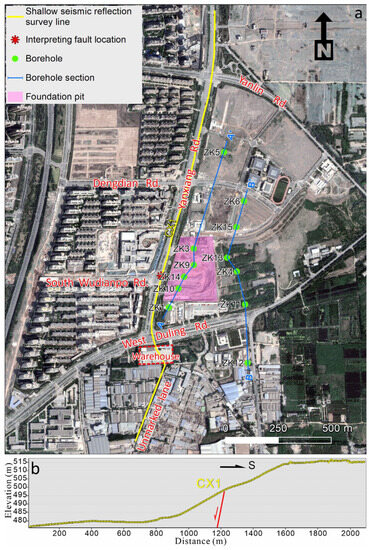
Figure 2.
(a) High-resolution satellite imagery illustrating the locations of the shallow seismic reflection survey line, drilling profiles and foundation pit. Image courtesy of Google Earth Professional 2023. (b) The micro-topographic profile across the surface scarp.
The shallow seismic reflection data were collected using the Canadian Aries digital seismic instrument, and the large-scale SM28B with a capacity of 28 T was selected as the controllable seismic source. Based on field tests, 704 geophones were used for data collection, with a shot interval of 9–15 m. The scanning frequency of the seismic source ranged from 10 to 110 Hz, with a scanning length of 12 s. The geophone spacing was 3 m and we recorded data on >40 of these sensors per source location. The sampling interval was set to 0.5 ms, and the recording length was 2 s.
The 2D seismic reflection data were processed by a workstation and a PC-Cluster (672-core) system. The data processing included datum statics, amplitude compensation, refraction first-break time statics, pre-stack noise suppression, surface consistent deconvolution, post-stack pipeline wave suppression, residual statics, velocity analysis, de-noising after stack, post-stack migration and so on. The shallow seismic reflection related work was carried out by China Coal Technology Engineering Group, Xi’an Research Institute.
3.3. Drilling
In order to locate correlative strata across the fault and to estimate the displacements, two drilling profiles A–A′ and B–B′, including 12 boreholes, were projected in the study area (Figure 2a). Profile A–A′ has a total length of 771 m and includes six boreholes, numbered as ZK1, ZK10, ZK14, ZK9, ZK3 and ZK5 from south to north, with spacing of 100 m, 62 m, 71 m, 66 m and 472 m, respectively. The depth of the boreholes ranges from 90 to 129 m, with a cumulative footage of 691 m. The length of the drilling profile B–B′ is close to 765 m and the cumulative footage is 724 m, including 6 boreholes with depths ranging from 111 m to 129 m. From south to north, the boreholes are named ZK12, ZK11, ZK4, ZK13, ZK15 and ZK6, with spacing of 277 m, 157 m, 74 m, 137 m and 120 m. During the construction, the “folding method” was used to determine the layout of the boreholes. This method approaches the fault from sides to center, emphasizing dynamic construction and analysis [19,20]. Each column of the boreholes was completely photographed and well logged, and the coordinates and elevations of the boreholes were obtained using Global Position System Real-Time Kinematic (GPS RTK) measurements. It is a challenge to correlate the eolian loess–paleosol strata in a loess slope region; hence, most of the boreholes were drilled through the loess layer to the fluvial formations, with an average depth of 118 m. Determination of the ages of the loess–paleosol sequence relied on the chronostratigraphic work by Ding et al. [21] (Table 1).

Table 1.
Top and bottom boundary ages of the paleosol S0–S5 (adapted from ref. [21]).
3.4. Excavation Profiles of a Foundation Pit
As part of the “Qujiang New District Phase II Project”, a large foundation pit was excavated across the fault, which was helpful to investigate the fault deformation history, since the foundation pit revealed the Upper Pleistocene paleosol S1 layer. This layer is one of the most significant marker layers in the study area and provides direct evidence for determining the Late Pleistocene activity on the fault. However, it is hard to take photos of all of the foundation pit walls because of the irregular shape of each part of the excavation and the requirement for guniting after excavating each section. Therefore, continuous observation on the foundation pit excavation was conducted over a month, and photos of each newly exposed stratigraphic profile were captured. Then, the profiles were marked on a map, and the profile photos were arranged based on their relative positions for comprehensive analysis.
4. Results
The aforementioned remotely sensed data, especially the DEM and DSM, show clearly lineament of the surface scarp, which has been identified to be a fault scarp in previous studies [2,3,4,7]. The results of the shallow seismic reflection survey, drilling and excavation profiles of the foundation pit are detailed below.
4.1. Shallow Seismic Reflection Profile
The CX1 reflection profile was heavily interfered with by ambient noise from pipelines and vehicles, which led to limited subsurface information about the study area (Figure 3). Bottom boundaries of the Quaternary and Pliocene strata were interpreted and marked as TQ and TN2, and the strata underlying the TN2 were poorly resolved. The Quaternary and Pliocene strata deepen northward, offset by one normal fault, as distinguished in Figure 3. The fault shows a northward dipping with an angle of 72°–78°, and can be traced up to within 100 m of the surface. But the structure details are difficult to resolve at depth shallower than 100 m. The net vertical offset in the Quaternary strata is close to 7 m. Projection of the fault to the surface coincides with the surface scarp at common-depth-point (CDP) 665 of the survey line, which can be interpreted as the Wangjiabian–Houjiawan Fault (F1-1a).
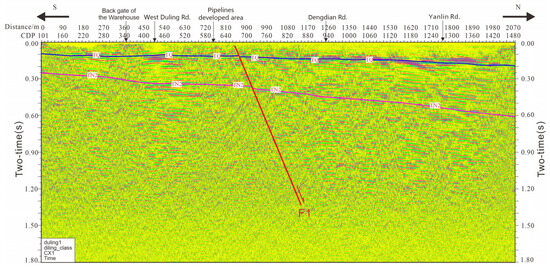
Figure 3.
The time profile of the survey line CX1.
4.2. Drilling Profiles
4.2.1. Profile A–A′
According to lithology, color, material composition and sedimentary structure, 10 stratigraphic layers can be identified from the drilled core columns in profile A–A′ (Figure 4a). Layers ① to ⑨ are the eolian loess–paleosol strata, whilst layer ⑩ is fluvial deposition. The details of each layer from top to bottom are described as follows.
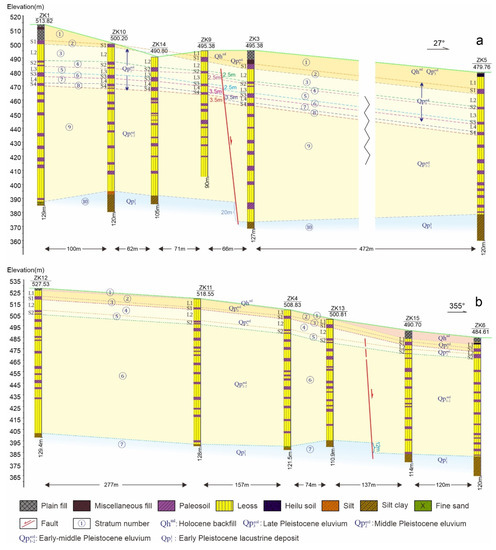
Figure 4.
Stratigraphic lithology of the drilling profile A–A′ (a) and profile B–B′ (b).
Layer ① includes backfill, heilu soil and loess. Heilu soil (S0) has uniform soil texture, visible pores and massive structures, and contains calcareous streaks and concretions. The loess layer is labeled as L1, which is the first layer of the eolian loess sequence, with a uniform soil texture, visible pores and a yellow-brown color. The heilu soil and loess only exist in the individual boreholes. The backfill and heilu soil were formed during Holocene, while the loess layer L1 was formed during the Late Pleistocene.
Layer ② is the Upper Pleistocene paleosol S1 layer, with a reddish-brown color. The soil texture in this layer is uniform with visible pores, presenting massive structures and containing a higher concentration of white calcareous streaks and concretions. This layer is one of the most significant marker layers in the study area, which was also revealed by the foundation pit; details of this layer are described below.
Layer ③ is the loess layer L2 formed during the Middle Pleistocene. It has a uniform soil texture with visible pores and contains a modicum of concretions and calcareous streaks. The color of this layer is brownish-yellow.
Layer ④ is the paleosol layer S2 formed during the Middle Pleistocene, with a reddish-brown color. The soil texture in this layer is uniform, with visible pores and massive structures. It contains a higher concentration of white calcareous streaks and concretions.
Layers ⑤ and ⑦ are the loess layers L3 and L4, which show similar features to layer ③. Additionally, layers ⑥ and ⑧ are the paleosol layers S3 and S4, and their natures are similar to layer ④.
Layer ⑨ is the loess–paleosol sequence underlying the paleosol S4, which was formed during the Early to Middle Pleistocene. Due to the difficulty in correlating the strata in the profile, it is categorized as one major layer. This set of stratigraphy has a uniform soil texture with visible pores and contains white calcareous streaks and concretions. The loess layer has a lighter color, while the paleosol layer has a darker color. Both the loess and palesol layers exhibit a pattern: the deeper the layer, the smaller the pores and the darker the color.
Layer ⑩ consists of silty clay, silt and fine sand. It also has a uniform soil texture with a sticky characteristic, and contains iron oxide-rich silt, as well as a modicum of concretions. The fine sand is uniform in texture, including components like quartz and feldspar. It has a yellow-brown color and was formed during the Early Pleistocene. This layer is distinct from the overlying strata and is characterized by fluvial–lacustrine deposition, which indicates its relatively horizontal layering.
4.2.2. Profile B–B′
Profile B–B′ is similar to profile A–A′ but with slight differences, as explained below. According to lithology, color, material composition and sedimentary structure, the stratum in profile B–B′ can be divided into seven layers (Figure 4b).
Layer ① includes backfill and heilu soil, which were formed during the Holocene.
Layer ② is the first layer of the eolian loess L1 formed during the Late Pleistocene. It has uniform soil texture, with visible pores and a yellow-brown color.
Layers ③, ④ and ⑤ in profile B–B′ correspond to layers ②, ③ and ④ in profile A–A′, respectively, and the descriptions of these layers remain consistent with the previous text. In profile B–B′, the loess–paleosol sequence underlying the paleosol S2 is quite difficult to correlate; thus, it was categorized as one major layer ⑥, similar to layer ⑨ in profile A–A′. Layer ⑦ in profile B–B′ was formed in the fluvial–lacustrine environment, which included silty clay, silt and fine sand, corresponding to layer ⑩ in profile A–A′.
4.2.3. Marker Layers and Fault Analysis
As mentioned above, the age constraints of the loess–paleosol layers in the drilling profiles relied on a previously established chronological scale; the top and boundary ages of the paleosol layers S0–S5 are listed in Table 1.
In drilling profile A–A′, the main marker layers that exhibit relatively stable, continuous thickness and distinct color are layers ②, ④, ⑥, ⑧ and ⑩. Layers ②, ④, ⑥ and ⑧ correspond to the eolian paleosol S1–S4, while layer ⑩ represents a silty clay layer deposited in a fluvial–lacustrine environment. Similarly, in the drilling profile B–B′, marker layers ③ and ⑤ correspond to the S1–S2 paleosol, while layer ⑦ is the silty clay layer. Among them, the paleosol S1 (layer ② in profile A–A′, layer ③ in profile B–B′) and the silty clay layer (layer ⑩ in profile A–A′, layer ⑦ in profile B–B′) are most helpful to identify the Late Pleistocene activity and location of the Wangjiabian–Houjiawan Fault (F1-1a). The paleosol S1 can be further divided into four sub-layers (Figure 5b). There is a thin light-colored layer at the top (i), followed by a reddish-brown layer containing lots of white calcareous streaks (ii). Layer (iii) has a lighter reddish-brown color with less calcareous streaks, and a calcareous concretion layer (iv) is at the bottom. Paleosol S1 was found in most boreholes, with the exception of ZK14, where it was excavated before drilling.
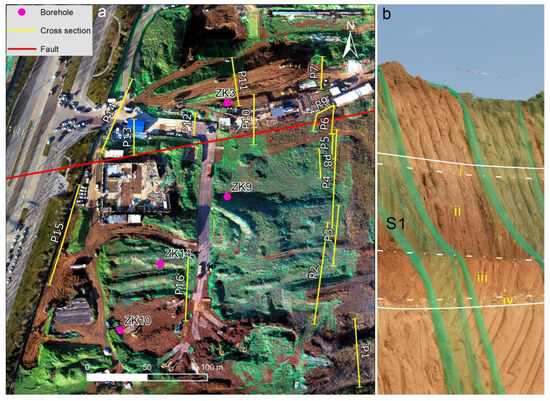
Figure 5.
(a) Unmanned arial vehicle photogrammetry of the foundation pit illustrating the locations of the stratigraphic profiles. (b) Stratigraphic section of the paleosol S1 layer.
The extension trend in each marker layer in profile A–A′ shows a clear change in the slope between ZK3 and ZK9, indicating the presence of a fault. Marker layers ④, ⑥, ⑧ and ⑩ are faulted, and their respective displacements are shown in Table 2. The marker layer ② shows continuous extension without any noticeable vertical displacement, which means that the fault does not extend upwards into layer ②.

Table 2.
Fault displacements of the marker layers from the drilling profiles.
The depth variations in marker layer ⑦ in profile B–B′ suggest the existence of a fault between ZK13 and ZK15, with a vertical displacement of 12 m at the top boundary. The slope of marker layers ③ and ⑤ exhibits slight variations in the drilling profile, possibly due to the non-linear alignment of the boreholes. In general, it is difficult to distinguish the displacement presented in marker layers ③ and ⑤.
In summary, the drilling profiles reveal that the Wangjiabian–Houjiawan Fault (F1-1a) is located between boreholes ZK3 and ZK9 in profile A–A′, and between boreholes ZK13 and ZK15 in profile B–B′. The fault strikes ~79° in the study area, and coincides with the scarp. The buried depth of the fault up-breakpoint is close to 15 m. The fault was active in the Middle Pleistocene around the study area, with a vertical displacement of 2.5 m. The top boundary of the fluvial–lacustrine deposits, formed during the Early Pleistocene, was offset 12–20 m.
4.3. Excavation Profiles of Foundation Pit
The scope of the foundation pit is shown in Figure 2a. We mapped and photographed more than 20 profiles, which clearly revealed the distribution characteristics of the paleosol S1 layer (Figure 5a). The locations and photos of 16 profiles (P1–P16) are shown in Figure 5a and Figure 6. Among them, profiles P5 to P15 are located near or traversed by the fault. As shown in the photos, the paleosol S1 layer in those profiles are continuous, with no displacement in the stratigraphy. Although profiles P12–P15 are not connected, the extension of the S1 layer also indicates that there is no obvious displacement in the stratigraphy. This suggests that the Wangjiayan–Houjiawan Fault (F1-1a) has not been active in the study area since the Late Pleistocene.
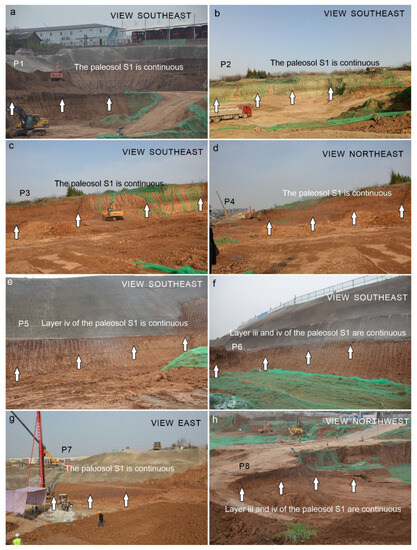
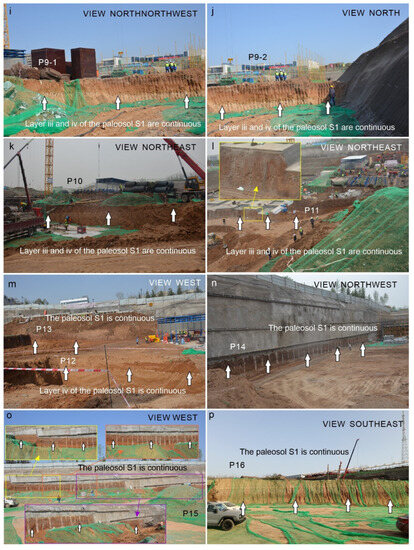
Figure 6.
Photographs of the profiles in the foundation pit. (a–h) Photographs of Profiles P1–P8. (i,j) Photographs of Profiles P9. (k–p) Photographs of Profiles P10–P16. The profile locations are shown in Figure 5a. The arrows in the photographs point to the paleosol S1.
5. Discussion
5.1. Activity and Distribution of the Wangjiabian–Houjiawan Fault
To assess the activity characteristics of the Wangjiabian–Houjiawan Fault (F1-1a), a few fault displacements in the Late Pleistocene were updated from previous studies according to the field investigations and consultation with a member of the “Active Fault Detection and Seismic Hazard Assessment in Xi’an City” project. The updated and the newly discovered fault displacements in the Late Pleistocene are shown in Table 3 by the numbers 22, 34–38 and 43. During the Late Pleistocene, the Wangjiabian–Houjiawan Fault (F1-1a) yielded vertical offsets of 1.5–2 m in the Bailu Loess Tableland and Shenhe Loess Tableland, with no displacement in the Shaoling Loess Tableland. We thus concluded that the Wangjiabian–Houjiawan Fault (F1-1a) is Late Pleistocene active in general, while the activity is relatively weaker in the Shaoling Loess Tableland.

Table 3.
Displacements along the Lintong–Chang’an Fault Zone since the Late Pleistocene.
The micro-topographic profile in this area was acquired using GPS RTK data. These data were collected along the shallow seismic reflection survey line (Figure 2b), which reveals that the relief of the surface scarp is close to 35 m. Subsequently, the fault was projected onto the topographic profile, revealing its position ranging from approximately one-third to one-half of the scarp from low to high. Previous studies had identified that the scarp was a result of both faulting and erosion [3,22].
5.2. Late Quaternary Activity Characteristics and Geological Significance of the Lintong–Chang’an Fault Zone
The displacement data from the Late Pleistocene along the LCFZ were gathered, drawing on both prior and ongoing research efforts (Table 3). In the table, the “Maximum value” represents the sum of the maximum fault displacements on each branch fault, while the “Average value” represents the sum of the average displacements on each branch fault in the same geomorphic unit. In addition, Figure 7a shows the along-strike variations in fault slip within different geomorphic units referenced by the above data.
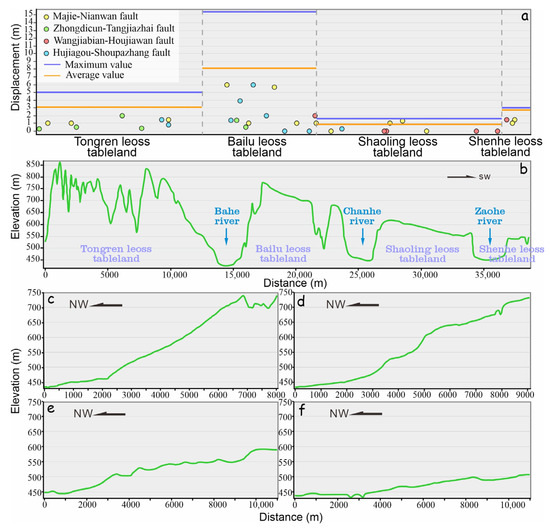
Figure 7.
(a) Vertical displacements since the Late Pleistocene along the Lintong–Chang’an Fault Zone (LCFZ). (b) Topographic profile along the LCFZ. (c–f) Topographic profiles across the LCFZ. Profile locations are shown in Figure 1c.
The overall activity of the LCFZ has been relatively weak since the Late Pleistocene (Table 3 and Figure 7a). Fault outcrops with no displacements in the Late Pleistocene strata can be found in the Bailu Loess Tableland and the Shaoling Loess Tableland. Based on the average fault displacements of 0.92–8.03 m, and the bottom boundary age of 127 ka of the paleosol S1 (Table 1), the average slip rate on the fault zone is estimated to be 0.011–0.075 mm/a since the Late Pleistocene. The fault zone shows the strongest faulting activity since the Late Pleistocene in the Bailu Loess Tableland, but much weaker within the other three geomorphic units. In those geomorphic units, the fault displacements, in order from largest to smallest, are the Bailu Loess Tableland, the Tongren Loess Tableland, the Shenhe Loess Tableland and the Shaoling Loess Tableland. Topographic profiles in Figure 7b–f show that both the elevation and the relief of the fault related geomorphic units decrease gradually from northeast to southwest (see the topographic profile locations in Figure 1c). This indicates that the activity of the LCFZ since the Late Pleistocene is irrelevant to the regional topographic expression, and it demonstrates a wave-like characteristic (Figure 7a).
Additionally, information regarding Late Pleistocene activity and slip rate data for other major active faults within the Weihe Graben, particularly around the Xi’an Depression, was also compiled (Table 4; Figure 1b). Among these active faults, the Northern Qinling Fault, as the southern boundary of the Xi’an Depression, is the most active one in the Weihe Graben. It is a Holocene active fault with multiple paleoearthquake events [23] and has controlled the sedimentary process of the Weihe Graben since Cenozoic [1,9]. The average vertical displacement along the Northern Qinling Fault within the past 14,000 years is close to 7.31 m [23], and the fault mainly exhibited a left-lateral strike-slip motion since the Late Quaternary, with a slip rate about 1 mm/a [24,25,26,27]. The Weihe Fault at the northern boundary of the Xi’an Depression is less active in the Holocene compared to the Northern Qinling Fault, and the average vertical displacement on the bottom boundary of the paleosol S1 is close to 20 m in the eastern segment [28]. The western tip of the fault displays a horsetail fractures feature, which may be attributed to a strike–slip motion (Figure 1b) [29,30]. The Longxian–Qishan–Mazhao Fault on the western boundary of the Xi’an Depression is primarily characterized by a left-lateral strike–slip motion, with an average displacement around 80 m since the Late Pleistocene [31]. However, as the eastern boundary of the Depression, the activity of the LCFZ since the Late Pleistocene is much weaker.

Table 4.
Slip rates on the main faults in the Weihe Graben since the Late Pleistocene.
Additionally, recent studies indicated that the Kouzhen–Guanshan Fault and the Weinan Loess Tableland Fault in the Weihe Graben also experienced a left-lateral strike–slip motion since the Late Quaternary. The strike–slip rate of the Kouzhen–Guanshan Fault is around 0.49 mm/a since the Late Pleistocene [33], and the left-lateral strike–slip motion along the Weinan Loess Tableland Fault was verified by oblique striae [37]. This suggests that most active faults within the Weihe Graben displayed a certain amount of left-lateral strike–slip motion since the Late Quaternary, which infers a possible strike–slip motion along the LCFZ. Furthermore, according to the seismic reflection profiles, there may be an additional fault on the northwestern side of the LCFZ accommodating a portion of the regional faulting motion [38,39], which might explain the relatively lower vertical slip rates along the LCFZ. Therefore, further investigations on the additional fault and the strike–slip motion of the LCFZ are needed.
6. Conclusions
Based on the “Qujiang New District Phase II Project” in Xi’an City, remotely sensed imagery data, shallow seismic reflection imaging, borehole data and excavation profiles of a foundation pit were utilized to demonstrate the distribution and Late Quaternary deformation of the Wangjiabian–Houjiawan Fault (F1-1a) of the LCFZ. It was observed that, within the Shaoling Loess Tableland, the Late Pleistocene activity of the Wangjiabian–Houjiawan Fault (F1-1a) is weak and that the fault is located at one-third to one-half of the scarp, from low to high. Our investigation further indicates that, during the Late Pleistocene, the activity of the LCFZ varied along the strike with a wave-like characteristic, irrelevant to the regional topographic expression. Compared to other faults in the Weihe Graben, the Late Pleistocene activity of the LCFZ is much weaker, which might be attributed to an additional fault on its northwestern side, accommodating part of the regional faulting motion and/or its strike–slip motion. This study also suggests that the ambient noise (e.g., underground pipelines and vehicles) and low water level area should be avoided when the shallow seismic reflection surveys are used to detect the concealed faults within a loess tableland. Additionally, boreholes should penetrate to the alluvial layer, as correlating the loess–paleosol layers can be challenging.
Author Contributions
Conceptualization, S.W. and Q.T.; methodology, S.W. and J.C.; formal analysis, S.W.; investigation, S.W., J.C., R.D., X.L., W.Y. and W.X.; writing—original draft preparation, S.W.; writing—review and editing, Q.T. and Z.T.; visualization, S.W. and Z.T.; supervision, Q.T. and J.C.; project administration, Y.H.; funding acquisition, S.W. and Q.T. All authors have read and agreed to the published version of the manuscript.
Funding
This research was funded by Natural Science Basic Research Program of Shaanxi, grant number 2023-JC-QN-0305 and Key Research and Development Program of Shaanxi, grant number 2021ZDLSF06-02.
Institutional Review Board Statement
Not applicable.
Informed Consent Statement
Not applicable.
Data Availability Statement
The data used to support the findings of this study are included within the article.
Acknowledgments
We thank Yaqin Shi from the Shaanxi Earthquake Agency for her help in the field work and constructive suggestions on the manuscript. Special thanks are given to Xi’an Qujiang New District Enterprise Asset Management Center for support during the construction of the boreholes.
Conflicts of Interest
The authors declare no conflict of interest.
References
- The Reseach Group on “Active Fault System around Ordos Massif”, State Seismological Bureau. Active Fault System around Ordos Massif; Seismological Press: Beijing, China, 1988. (In Chinese) [Google Scholar]
- Feng, X.; Dai, W.; Shi, Y.; Li, J.; Ren, J.; Han, H. Dislocation and Distribution Characteristics of the Lintong-Chang’an Fault. Seismol. Geol. 2006, 28, 579–588. [Google Scholar]
- Shi, Y.; Feng, X.; Dai, W.; Ren, J.; Li, X.; Chong, J. Cause Analysis of the Scarps on Lintong-Chang’an Fault Zone. Quat. Sci. 2008, 28, 721–732. [Google Scholar]
- Shi, Y.; Feng, X.; Dai, W.; Li, X.; Ren, J.; Chong, J. Geometric Structure and Formation Mechanism of Lintong-Chang’an Fault Zone. Acta Seismol. Sin. 2008, 21, 156–169. [Google Scholar] [CrossRef]
- Shi, Y.; Feng, X.; Li, J.; Dai, W.; Ren, J.; Li, X. Characteristics of the Activity of the Lintong-Chang’an Fault in the Late Pleistocene. Earthq. Res. China 2007, 23, 286–294. [Google Scholar]
- Ren, J.; Peng, J.; Wang, F.; Liu, C.; Feng, X.; Dai, W. The Research of Deep Structural Features of Weihe Basin and Adjacent Areas. Chin. J. Geophys. 2012, 55, 2939–2947. [Google Scholar]
- Shaanxi Earthquake Agency. Engineering Technical Report of Xi’an Active Fault Detection and Seismic Risk Assessment; Shaanxi Earthquake Agency: Xi’an, China, 2007. (In Chinese) [Google Scholar]
- Official Website of Qujiang New District Management Council. Available online: Http://Qjxq.Xa.Gov.Cn/Zwgk/Ndzdxxgk/Ggzypz/Zfcg/6131d55af8fd1c0bdc4f7ba4.Html (accessed on 4 July 2023).
- Zhang, Y.Q.; Mercier, J.L.; Vergély, P. Extension in the Graben Systems around the Ordos (China), and Its Contribution to the Extrusion Tectonics of South China with Respect to Gobi-Mongolia. Tectonophysics 1998, 285, 41–75. [Google Scholar] [CrossRef]
- He, C.; Yang, C.-J.; Rao, G.; Yuan, X.-P.; Roda-Boluda, D.C.; Cheng, Y.; Yang, R.; Zhang, L.; Yao, Q. Seismic Assessment of the Weihe Graben, Central China: Insights from Geomorphological Analyses and 10Be-Derived Catchment Denudation Rates. Geomorphology 2020, 359, 107151. [Google Scholar] [CrossRef]
- Sun, J. Long-Term Fluvial Archives in the Fen Wei Graben, Central China, and Their Bearing on the Tectonic History of the India-Asia Collision System during the Quaternary. Quat. Sci. Rev. 2005, 24, 1279–1286. [Google Scholar] [CrossRef]
- Han, H.; Zhang, Y.; Yuan, Z. The Evolution of Weihe Down-Faulted Basin and the Movement of the Fault Blocks. J. Seismol. Res. 2002, 25, 362–368. [Google Scholar]
- Li, Z.; Li, W.; Li, Y.; Li, Y.; Han, W.; Wen, J.; Chen, M.; Qin, Z. Sedimentary Facies of the Cenozoic in Weihe Basin. J. Palaeogeogr. 2015, 17, 529–540. [Google Scholar] [CrossRef]
- The Earthquake Disaster Prevention Department of the State Seismological Bureau. Catalogue of Chinese Historical Strong Earthquakes (23rd Century B.C. to 1911 A.D.); Seismological Press: Beijing, China, 1995. (In Chinese) [Google Scholar]
- Feng, X.; Ma, J.; Zhou, Y.; England, P.; Parsons, B.; Rizza, M.A.; Walker, R.T. Geomorphology and Paleoseismology of the Weinan Fault, Shaanxi, Central China, and the Source of the 1556 Huaxian Earthquake. JGR Solid Earth 2020, 125, e2019JB017848. [Google Scholar] [CrossRef]
- Wang, T.; Zeng, Z.; Yang, T.; Jian, K.; Gu, K. Time Limit of Lishan Uplift and Its Geological Significance. Geol. Shaanxi 2019, 37, 42–48. [Google Scholar]
- EarthExplorer of USGS. Available online: https://Earthexplorer.Usgs.Gov/ (accessed on 4 July 2023).
- ASF Data Search of NASA EARTHDATA. Available online: Https://Search.Asf.Alaska.Edu/#/ (accessed on 4 July 2023).
- Lei, Q.; Chai, C.; Meng, G.; Du, P.; Wang, Y.; Xie, X. Method of Locating Buried Active Fault by Composite Drilling Section Doubling Exploration. Seismol. Geol. 2011, 33, 45–55. [Google Scholar] [CrossRef]
- Liu, C.; Lei, Q.; Du, P.; Wu, Z.; Li, Z.; Yu, S.; Yang, S.; Wang, Y. Activity Characteristic of the Two Buried Faults in Zhongwei Basin along the Northeastern Margins of Tibetan Plateau, China, by Means of Shallow Seismic and Composite Drilling Section Exploration. Appl. Sci. 2022, 12, 12074. [Google Scholar] [CrossRef]
- Ding, Z.; Yu, Z.; Liu, T. Progress in Loess Research (Part 3): Time Scale. Quat. Sci. 1991, 4, 336–348. [Google Scholar]
- Li, D.; Du, J.; Ma, Y.; Xiao, A. The Activity of the Lintong-Chang’an Fracture Zone, Xi’an City since the Late Pleistocene. Earth Sci. Front. 2013, 20, 46–57. [Google Scholar]
- Shaanxi Earthquake Agency. Northern Qinling Mountains Active Fault Zone; Seismological Press: Beijing, China, 1996. (In Chinese) [Google Scholar]
- Zhang, Y.; Liao, C.; Shi, W.; Hu, B. Neotectonic Evolution of the Peripheral Zones of the Ordos Basin and Geodynamic Setting. Geol. J. China Univ. 2006, 12, 285–297. [Google Scholar]
- Mercier, J.L.; Vergely, P.; Zhang, Y.Q.; Hou, M.J.; Bellier, O.; Wang, Y.M. Structural Records of the Late Cretaceous–Cenozoic Extension in Eastern China and the Kinematics of the Southern Tan-Lu and Qinling Fault Zone (Anhui and Shaanxi Provinces, PR China). Tectonophysics 2013, 582, 50–75. [Google Scholar] [CrossRef]
- Cui, D.; Hao, M.; Li, Y.; Wang, W.; Qin, S.; Li, Z. Present-Day Crustal Movement and Strain of the Surrounding Area of Ordos Block Derived from Repeated GPS Observations. Chin. J. Geophys. 2016, 59, 3646–3661. [Google Scholar] [CrossRef]
- Yang, C.; Ji, L.; Yang, Y.; Su, L.; Wang, Y.; Shi, H. Present-Day Activity and Seismic Potential of the North Qinling Fault, Southern Ordos Block, Central China, as Revealed from GPS Data and Seismicity. Front. Earth Sci. 2023, 10, 1058243. [Google Scholar] [CrossRef]
- Tian, Q.; Zhou, B.; Li, X.; Shi, J.; Wei, Q.; Bian, J. Distribution of Yangjia Village-Yaodian Section of Weihe Fault and the Characteristics of Its Late Quaternary Activity. Seismol. Geol. 2016, 38, 141–151. [Google Scholar]
- Kim, Y.-S.; Sanderson, D.J. Structural Similarity and Variety at the Tips in a Wide Range of Strike–Slip Faults: A Review. Terra Nova 2006, 18, 330–344. [Google Scholar] [CrossRef]
- Shaanxi Earthquake Agency. Engineering Technical Report of Xingping Active Fault Detection and Seismic Risk Assessment; Shaanxi Earthquake Agency: Xi’an, China, 2022. (In Chinese) [Google Scholar]
- Wang, S.; Shi, Y.; Feng, X.; Tian, Z. Late Quaternary sinistral strike-slipping of the Liupanshan-Baoji fault zone: Implications for the growth of the northeastern Tibetan Plateau. Geomorphology 2021, 380, 107628. [Google Scholar] [CrossRef]
- Lin, A.; Rao, G.; Yan, B. Flexural Fold Structures and Active Faults in the Northern–Western Weihe Graben, Central China. J. Asian Earth Sci. 2015, 114, 226–241. [Google Scholar] [CrossRef]
- Yang, C.; Li, X.; Feng, X.; Zhu, L.; Li, M.; Zhang, E. The Late Quaternary and Present-Day Activities of the Kouzhen-Guanshan Fault on the Northern Boundary of Weihe Graben Basin, China. Seismol. Geol. 2021, 43, 504–520. [Google Scholar] [CrossRef]
- Mi, F.; Han, H.; Jin, J.; Lio, H. Nowadays Active Features of the Kouzhen-Guanshan Faults. J. Chang. Univ. Earth Sci. Ed. 1993, 15, 40–47. [Google Scholar]
- Li, X.; Ran, Y. The Northern Huashan and Weinan Loess Tableland active faults. North China Earthq. Sci. 1983, 1, 10–18. [Google Scholar]
- Li, G.; Li, C.; Li, X.; Ma, J. Late Quaternary Paleoearthquake Research of Weinan Plateau Front Fault. South China J. Seismol. 2019, 39, 65–70. [Google Scholar] [CrossRef]
- Ma, J. Surface Rupture and Its Seismogenic Faults of 1556 Huaxian M 8¼ Earthquake. Ph.D. Thesis, Institute of Geology, China Earthquake Administration, Beijing, China, 2019. (In Chinese). [Google Scholar]
- Ren, J.; Feng, X.; Wang, F.; Peng, J.; Liu, C.; Dai, W.; Li, G.; Zhang, Y.; Ma, J. Fine Crust Structures of Xi’an Sag in the Weihe Basin Revealed by a Deep Seismic Reflection Profile. Chin. J. Geophys. 2013, 56, 513–521. [Google Scholar]
- Li, Z.; Song, Y.; Gao, H.; Yuan, H.; Cheng, Y.; Cong, L. Study on the Strike of Western Lintong-Chang’an Fault (F_N). Earthq. Res. China 2014, 30, 272–279. [Google Scholar]
Disclaimer/Publisher’s Note: The statements, opinions and data contained in all publications are solely those of the individual author(s) and contributor(s) and not of MDPI and/or the editor(s). MDPI and/or the editor(s) disclaim responsibility for any injury to people or property resulting from any ideas, methods, instructions or products referred to in the content. |
© 2023 by the authors. Licensee MDPI, Basel, Switzerland. This article is an open access article distributed under the terms and conditions of the Creative Commons Attribution (CC BY) license (https://creativecommons.org/licenses/by/4.0/).